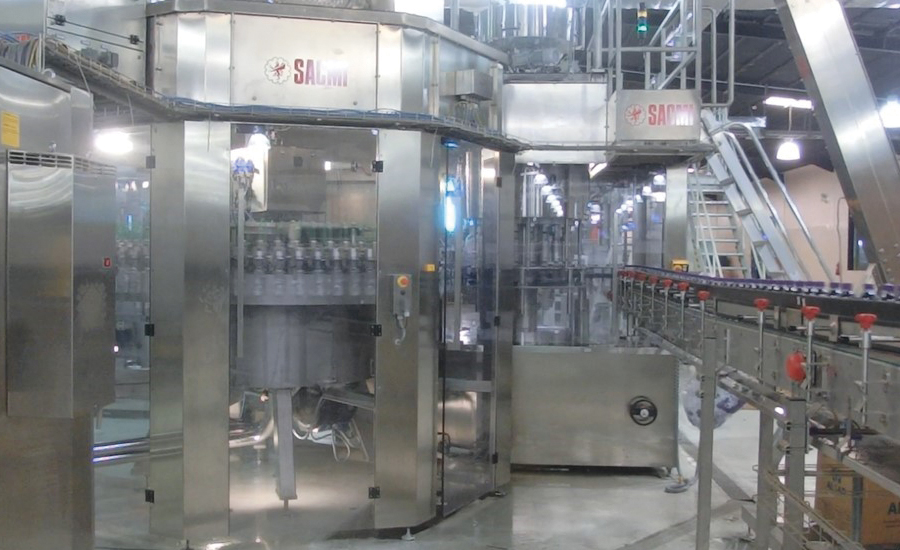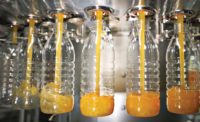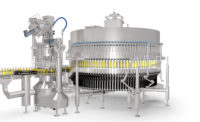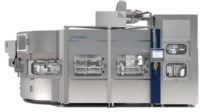The diversity of SKUs and bottle formats, the requirement to fill smaller batches, and the need to run lighter bottles and caps all are impacting the use of filling equipment, which also must be fast, flexible and capable of handling a variety of products.
Filling systems also are employing more electronics than the mechanical machines of the past, says Barry Fenkse, product manager of filling technology at Krones Inc., Franklin, Wis.
“They are more flexible, allowing optimization of each product SKU,” Fenske explains. “We have revamped the drive train where gears are replaced by servo motors. Change parts have been lightweighted, and we have locking systems that require less hands on in order to change out.
“We have fillers specific to one industry type, fillers that cater to more than one type, and we even have fillers that handle multiple industry types — hot fill, cold fill, carb, non-carb, juice, water and beer — all in one machine,” he adds.
One of Krones’ newest releases, the Craftmate, is a can filler for the craft beer market that is less expensive, has a smaller footprint and can fill as many as 80 to 250 cans a minute, Fenske says.
Along with the need for quick changeovers and flexible equipment, Imola, Italy-based Sacmi notes that the need to fill juices containing high amounts of fibers, pulps and even chunks of fruit has resulted in the use of a more complex monoblock system in between the rinsing and filling carousels.
“Standard filling valves are not designed for filling pulpy products, and even if specifically designed, it would be almost impossible to guarantee the same constant quality of suspended solids,” a Scami spokesperson explains. “The dosing carousel pours the correct quantity of fibers, pulps or fruit chunks inside each bottle. The filling carousel will then add the desired quantity of clear juice.”
The dosing operation can be either electronic or mechanical using dosing pistons, the company adds.
The number of beverages and bottle formats on beverage lines along with the explosion of the craft beer market also are impacting filling solutions, says Manfred Härtel, filling product manager for Dortmund, Germany-based KHS.
“There is a requirement to fill smaller batches, which increases the number of frequent changes in beverage, bottle size and packaging parts,” Härtel says. “The craft brewery market is also growing. Therefore, smaller capacities are needed. KHS offers a microfiller with a capacity of 8,000 cans or bottles per hour or more. Mixed beer beverages, new flavors and packaging call for more flexible systems.”
Equipment suppliers also are innovating when it comes to hot-fill solutions. Hünenberg, Switzerland-based Sidel offers fully integrated and flexible PET hot-fill packaging solutions and currently has more than 1,000 pieces of hot-fill packaging equipment installed in facilities worldwide.
“Our packaging engineers and designers are dedicated to developing attractive and sustainable PET bottles to differentiate beverages on the supermarket shelf,” Sidel Filling Product Manager Gabriele Gatti says. “We employ the processing equipment and capabilities from Tetra Pak Processing Systems to ensure processing and filling systems are seamlessly combined to reduce downtime, consumption and costs.”
Safe filling and monitoring systems
Ensuring that bottles are filled correctly, safely and hygienically remains a top priority for packaging experts, they say. The sterilization of bottle caps also is part of the process.
“The caps can be treated along the cap chute using sterilizing solutions and/or by means of UV lamps,” Sacmi’s spokesperson notes. “We ensure the most strict, ultra-clean filling standards and have in our portfolio all the existing technologies for the control of filling, including electronic volumetric (both magnetic and mass flowmeter), level probe, mechanical level, vacuum level, load cells, and our patented volume by time.”
Noting the importance of monitoring filling functions and quality, KHS recently developed an analysis system for the filling process that includes pressure sensors in each filling valve that control the entire process for each bottle.
“Malfunctions are displayed immediately,” Härtel says. “Preventive maintenance, condition-based monitoring and easy troubleshooting are also included. We also offer optical foaming detection. Monitoring bottle foaming with cameras is crucial for filling without an operator.”
To meet the production demands of sensitive and natural beverages like juices, still drinks and teas, Sidel’s latest model for heat-resistant (HR) bottle production — the Matrix eHR blower — adds another dimension to the company’s hot-fill solutions by using electricity instead of heat to mold the body of PET bottles.
“Compared with Sidel blowers that use traditional heating with oil, this innovative electrical mold heating and our Matrix blower technologies offer energy savings of up to 45 percent,” Gatti says. “A further savings of 25 percent can be achieved with the Ecoven, which uses infrared lamps with ceramics instead of metal reflections.”
During the past decade, filling technology has improved, particularly with the extensive use of electronics and better sensor technology.
KHS’ Härtel says, “We’ll see even smaller production batches, more frequent and faster product changeovers, fewer line operators and automatic quality control.” BI






